Applied System Thinking in Public Health: Obesity in Australia
VerifiedAdded on 2023/05/30
|7
|1556
|327
Report
AI Summary
This report examines the application of system thinking to address the growing problem of obesity in Australia. It identifies key stakeholders, including families and healthcare professionals, and their roles in obesity prevention. The report discusses obstacles to implementing a system thinking approach, such as the global scope of obesity and time lags in its effects. It proposes new governance strategies, including a holistic approach and improved understanding of system thinking, to enhance obesity interventions in Australia. The assignment highlights the importance of collaboration among stakeholders to develop effective solutions. Desklib offers a wealth of similar resources for students.
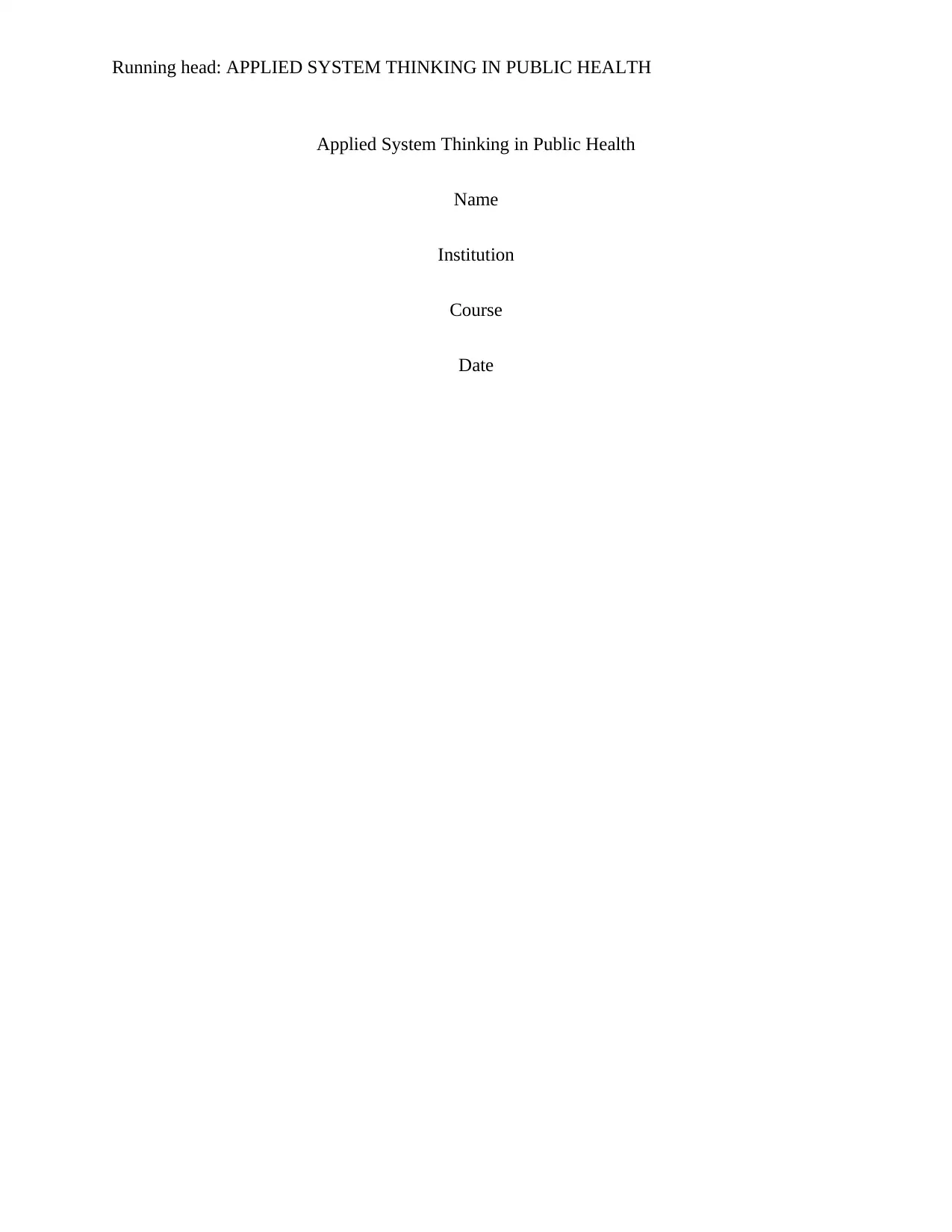
Running head: APPLIED SYSTEM THINKING IN PUBLIC HEALTH
Applied System Thinking in Public Health
Name
Institution
Course
Date
Applied System Thinking in Public Health
Name
Institution
Course
Date
Paraphrase This Document
Need a fresh take? Get an instant paraphrase of this document with our AI Paraphraser
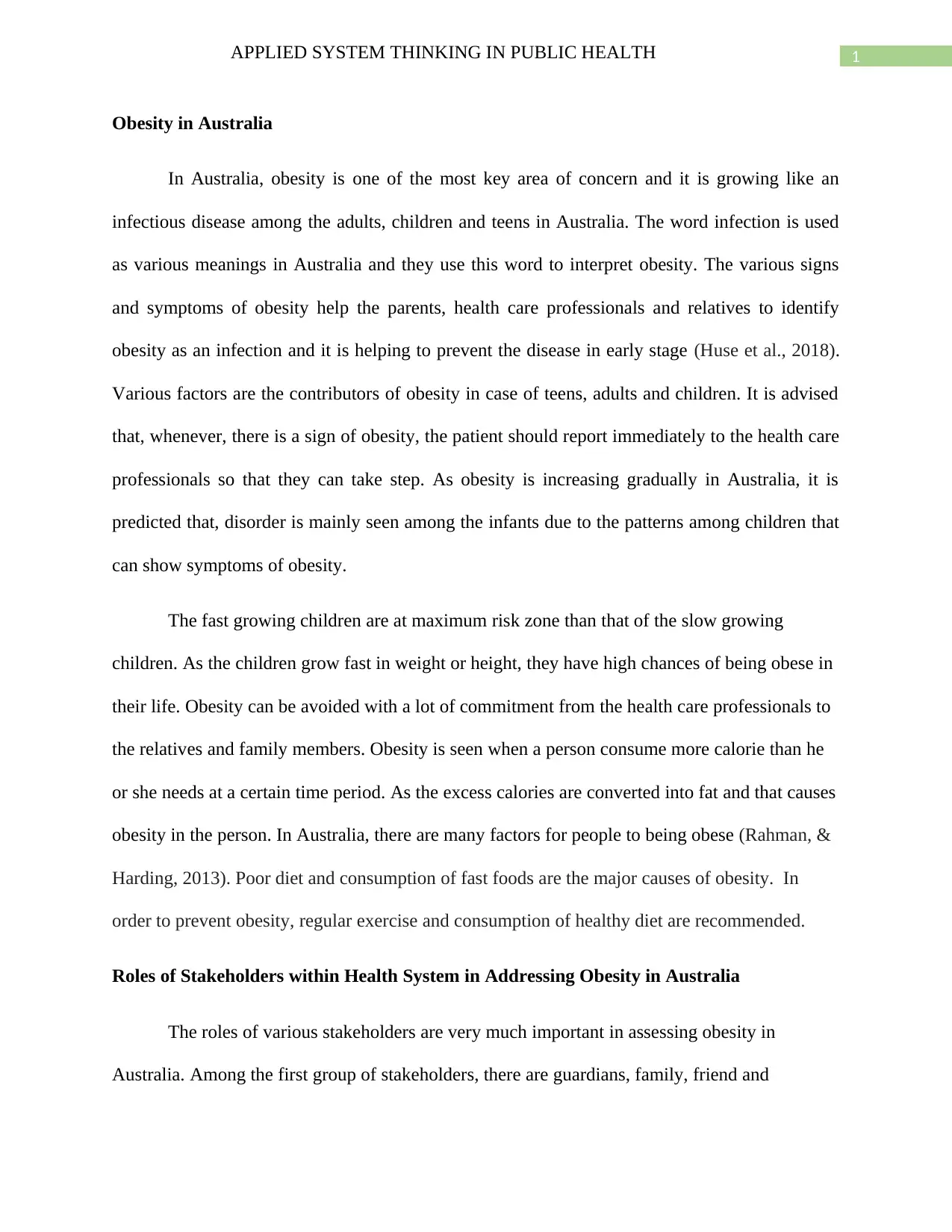
1APPLIED SYSTEM THINKING IN PUBLIC HEALTH
Obesity in Australia
In Australia, obesity is one of the most key area of concern and it is growing like an
infectious disease among the adults, children and teens in Australia. The word infection is used
as various meanings in Australia and they use this word to interpret obesity. The various signs
and symptoms of obesity help the parents, health care professionals and relatives to identify
obesity as an infection and it is helping to prevent the disease in early stage (Huse et al., 2018).
Various factors are the contributors of obesity in case of teens, adults and children. It is advised
that, whenever, there is a sign of obesity, the patient should report immediately to the health care
professionals so that they can take step. As obesity is increasing gradually in Australia, it is
predicted that, disorder is mainly seen among the infants due to the patterns among children that
can show symptoms of obesity.
The fast growing children are at maximum risk zone than that of the slow growing
children. As the children grow fast in weight or height, they have high chances of being obese in
their life. Obesity can be avoided with a lot of commitment from the health care professionals to
the relatives and family members. Obesity is seen when a person consume more calorie than he
or she needs at a certain time period. As the excess calories are converted into fat and that causes
obesity in the person. In Australia, there are many factors for people to being obese (Rahman, &
Harding, 2013). Poor diet and consumption of fast foods are the major causes of obesity. In
order to prevent obesity, regular exercise and consumption of healthy diet are recommended.
Roles of Stakeholders within Health System in Addressing Obesity in Australia
The roles of various stakeholders are very much important in assessing obesity in
Australia. Among the first group of stakeholders, there are guardians, family, friend and
Obesity in Australia
In Australia, obesity is one of the most key area of concern and it is growing like an
infectious disease among the adults, children and teens in Australia. The word infection is used
as various meanings in Australia and they use this word to interpret obesity. The various signs
and symptoms of obesity help the parents, health care professionals and relatives to identify
obesity as an infection and it is helping to prevent the disease in early stage (Huse et al., 2018).
Various factors are the contributors of obesity in case of teens, adults and children. It is advised
that, whenever, there is a sign of obesity, the patient should report immediately to the health care
professionals so that they can take step. As obesity is increasing gradually in Australia, it is
predicted that, disorder is mainly seen among the infants due to the patterns among children that
can show symptoms of obesity.
The fast growing children are at maximum risk zone than that of the slow growing
children. As the children grow fast in weight or height, they have high chances of being obese in
their life. Obesity can be avoided with a lot of commitment from the health care professionals to
the relatives and family members. Obesity is seen when a person consume more calorie than he
or she needs at a certain time period. As the excess calories are converted into fat and that causes
obesity in the person. In Australia, there are many factors for people to being obese (Rahman, &
Harding, 2013). Poor diet and consumption of fast foods are the major causes of obesity. In
order to prevent obesity, regular exercise and consumption of healthy diet are recommended.
Roles of Stakeholders within Health System in Addressing Obesity in Australia
The roles of various stakeholders are very much important in assessing obesity in
Australia. Among the first group of stakeholders, there are guardians, family, friend and
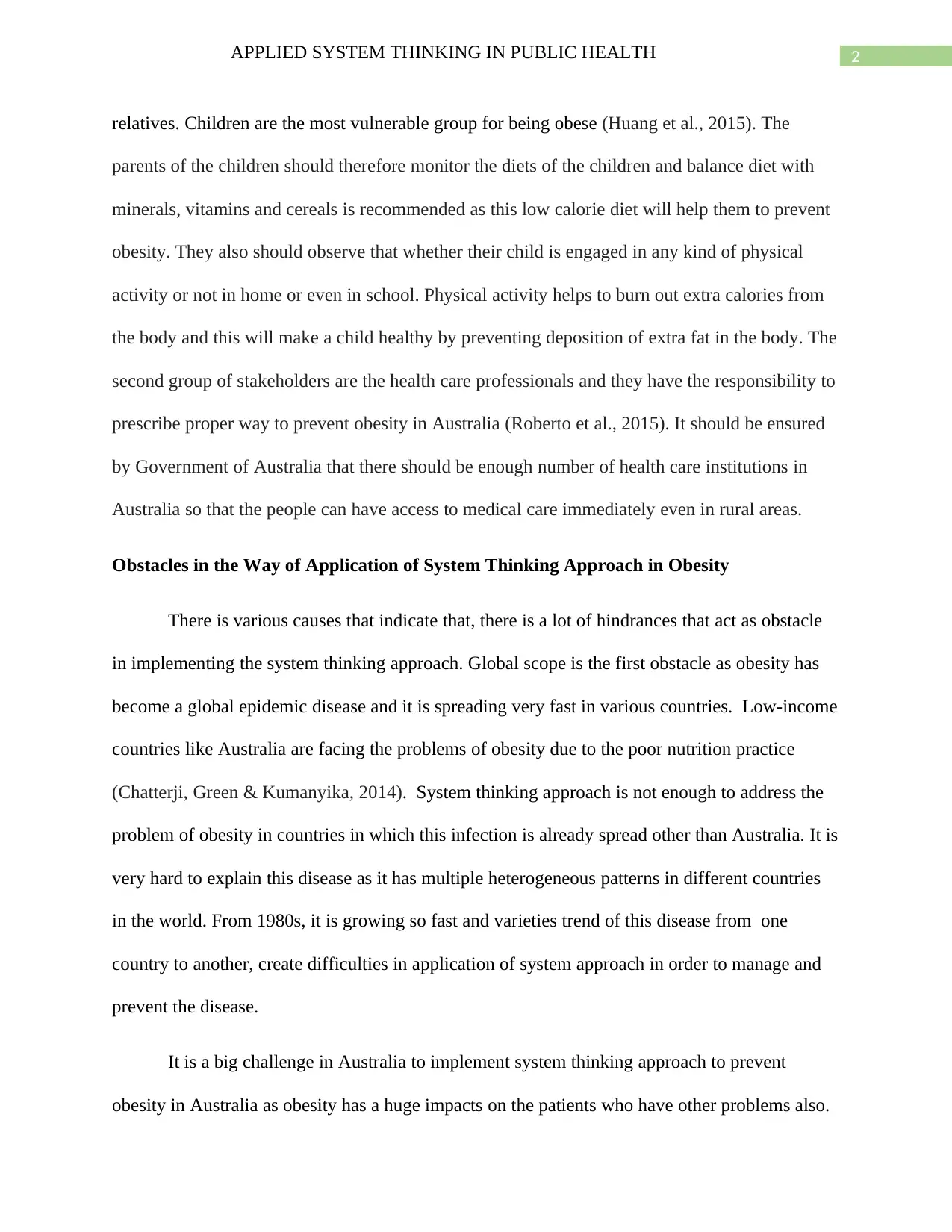
2APPLIED SYSTEM THINKING IN PUBLIC HEALTH
relatives. Children are the most vulnerable group for being obese (Huang et al., 2015). The
parents of the children should therefore monitor the diets of the children and balance diet with
minerals, vitamins and cereals is recommended as this low calorie diet will help them to prevent
obesity. They also should observe that whether their child is engaged in any kind of physical
activity or not in home or even in school. Physical activity helps to burn out extra calories from
the body and this will make a child healthy by preventing deposition of extra fat in the body. The
second group of stakeholders are the health care professionals and they have the responsibility to
prescribe proper way to prevent obesity in Australia (Roberto et al., 2015). It should be ensured
by Government of Australia that there should be enough number of health care institutions in
Australia so that the people can have access to medical care immediately even in rural areas.
Obstacles in the Way of Application of System Thinking Approach in Obesity
There is various causes that indicate that, there is a lot of hindrances that act as obstacle
in implementing the system thinking approach. Global scope is the first obstacle as obesity has
become a global epidemic disease and it is spreading very fast in various countries. Low-income
countries like Australia are facing the problems of obesity due to the poor nutrition practice
(Chatterji, Green & Kumanyika, 2014). System thinking approach is not enough to address the
problem of obesity in countries in which this infection is already spread other than Australia. It is
very hard to explain this disease as it has multiple heterogeneous patterns in different countries
in the world. From 1980s, it is growing so fast and varieties trend of this disease from one
country to another, create difficulties in application of system approach in order to manage and
prevent the disease.
It is a big challenge in Australia to implement system thinking approach to prevent
obesity in Australia as obesity has a huge impacts on the patients who have other problems also.
relatives. Children are the most vulnerable group for being obese (Huang et al., 2015). The
parents of the children should therefore monitor the diets of the children and balance diet with
minerals, vitamins and cereals is recommended as this low calorie diet will help them to prevent
obesity. They also should observe that whether their child is engaged in any kind of physical
activity or not in home or even in school. Physical activity helps to burn out extra calories from
the body and this will make a child healthy by preventing deposition of extra fat in the body. The
second group of stakeholders are the health care professionals and they have the responsibility to
prescribe proper way to prevent obesity in Australia (Roberto et al., 2015). It should be ensured
by Government of Australia that there should be enough number of health care institutions in
Australia so that the people can have access to medical care immediately even in rural areas.
Obstacles in the Way of Application of System Thinking Approach in Obesity
There is various causes that indicate that, there is a lot of hindrances that act as obstacle
in implementing the system thinking approach. Global scope is the first obstacle as obesity has
become a global epidemic disease and it is spreading very fast in various countries. Low-income
countries like Australia are facing the problems of obesity due to the poor nutrition practice
(Chatterji, Green & Kumanyika, 2014). System thinking approach is not enough to address the
problem of obesity in countries in which this infection is already spread other than Australia. It is
very hard to explain this disease as it has multiple heterogeneous patterns in different countries
in the world. From 1980s, it is growing so fast and varieties trend of this disease from one
country to another, create difficulties in application of system approach in order to manage and
prevent the disease.
It is a big challenge in Australia to implement system thinking approach to prevent
obesity in Australia as obesity has a huge impacts on the patients who have other problems also.
⊘ This is a preview!⊘
Do you want full access?
Subscribe today to unlock all pages.

Trusted by 1+ million students worldwide
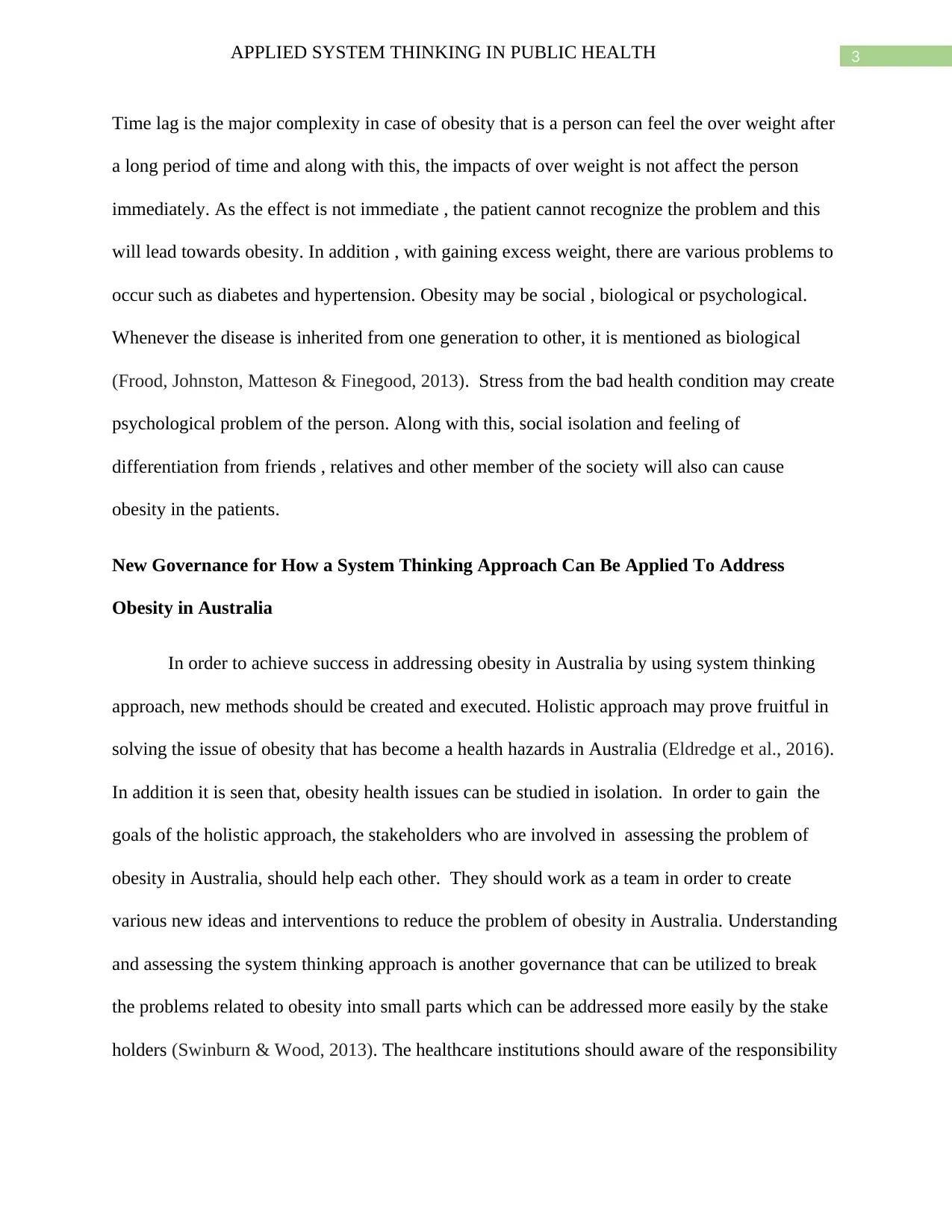
3APPLIED SYSTEM THINKING IN PUBLIC HEALTH
Time lag is the major complexity in case of obesity that is a person can feel the over weight after
a long period of time and along with this, the impacts of over weight is not affect the person
immediately. As the effect is not immediate , the patient cannot recognize the problem and this
will lead towards obesity. In addition , with gaining excess weight, there are various problems to
occur such as diabetes and hypertension. Obesity may be social , biological or psychological.
Whenever the disease is inherited from one generation to other, it is mentioned as biological
(Frood, Johnston, Matteson & Finegood, 2013). Stress from the bad health condition may create
psychological problem of the person. Along with this, social isolation and feeling of
differentiation from friends , relatives and other member of the society will also can cause
obesity in the patients.
New Governance for How a System Thinking Approach Can Be Applied To Address
Obesity in Australia
In order to achieve success in addressing obesity in Australia by using system thinking
approach, new methods should be created and executed. Holistic approach may prove fruitful in
solving the issue of obesity that has become a health hazards in Australia (Eldredge et al., 2016).
In addition it is seen that, obesity health issues can be studied in isolation. In order to gain the
goals of the holistic approach, the stakeholders who are involved in assessing the problem of
obesity in Australia, should help each other. They should work as a team in order to create
various new ideas and interventions to reduce the problem of obesity in Australia. Understanding
and assessing the system thinking approach is another governance that can be utilized to break
the problems related to obesity into small parts which can be addressed more easily by the stake
holders (Swinburn & Wood, 2013). The healthcare institutions should aware of the responsibility
Time lag is the major complexity in case of obesity that is a person can feel the over weight after
a long period of time and along with this, the impacts of over weight is not affect the person
immediately. As the effect is not immediate , the patient cannot recognize the problem and this
will lead towards obesity. In addition , with gaining excess weight, there are various problems to
occur such as diabetes and hypertension. Obesity may be social , biological or psychological.
Whenever the disease is inherited from one generation to other, it is mentioned as biological
(Frood, Johnston, Matteson & Finegood, 2013). Stress from the bad health condition may create
psychological problem of the person. Along with this, social isolation and feeling of
differentiation from friends , relatives and other member of the society will also can cause
obesity in the patients.
New Governance for How a System Thinking Approach Can Be Applied To Address
Obesity in Australia
In order to achieve success in addressing obesity in Australia by using system thinking
approach, new methods should be created and executed. Holistic approach may prove fruitful in
solving the issue of obesity that has become a health hazards in Australia (Eldredge et al., 2016).
In addition it is seen that, obesity health issues can be studied in isolation. In order to gain the
goals of the holistic approach, the stakeholders who are involved in assessing the problem of
obesity in Australia, should help each other. They should work as a team in order to create
various new ideas and interventions to reduce the problem of obesity in Australia. Understanding
and assessing the system thinking approach is another governance that can be utilized to break
the problems related to obesity into small parts which can be addressed more easily by the stake
holders (Swinburn & Wood, 2013). The healthcare institutions should aware of the responsibility
Paraphrase This Document
Need a fresh take? Get an instant paraphrase of this document with our AI Paraphraser

4APPLIED SYSTEM THINKING IN PUBLIC HEALTH
and roles of different stakeholders so that they can easily solve the problem of obesity in
Australia.
and roles of different stakeholders so that they can easily solve the problem of obesity in
Australia.
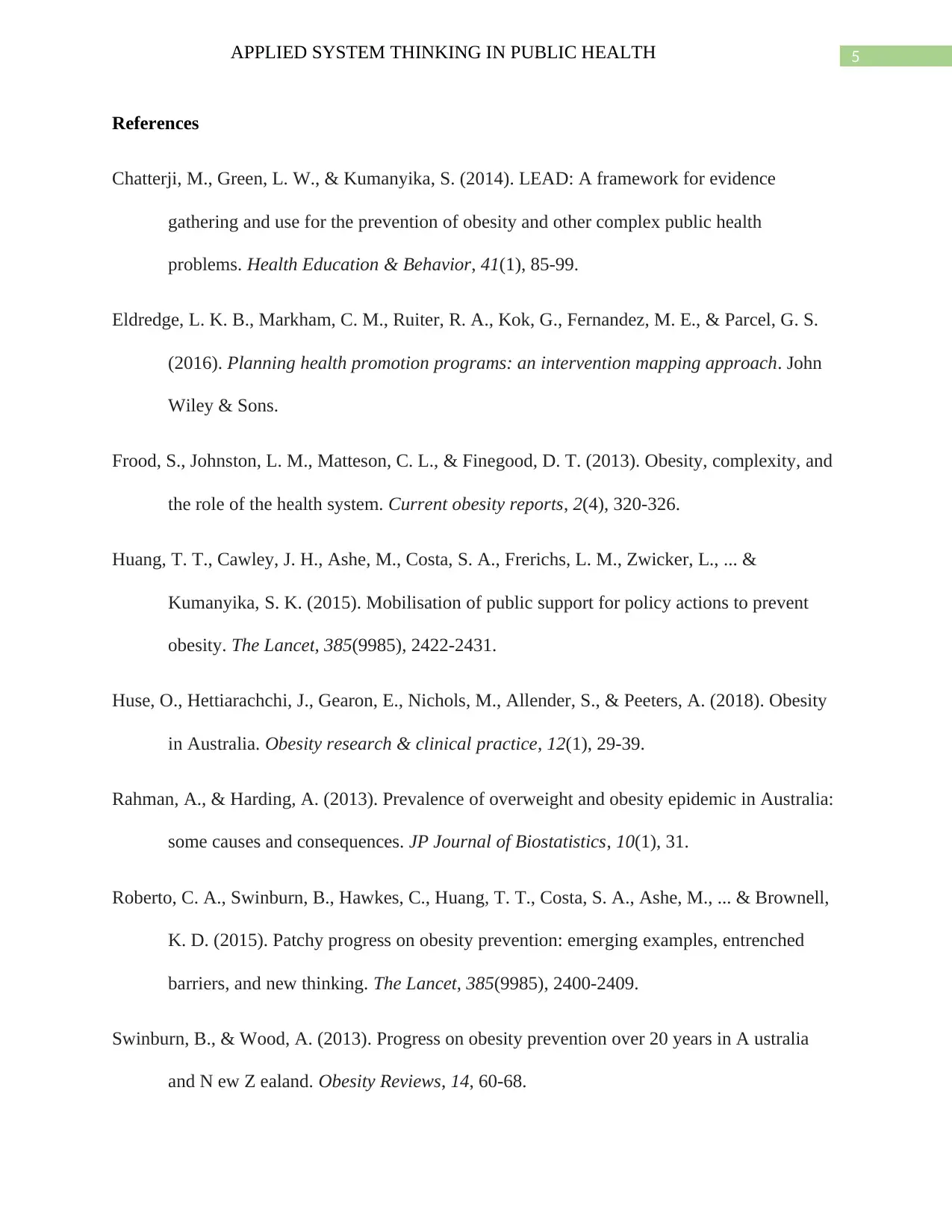
5APPLIED SYSTEM THINKING IN PUBLIC HEALTH
References
Chatterji, M., Green, L. W., & Kumanyika, S. (2014). LEAD: A framework for evidence
gathering and use for the prevention of obesity and other complex public health
problems. Health Education & Behavior, 41(1), 85-99.
Eldredge, L. K. B., Markham, C. M., Ruiter, R. A., Kok, G., Fernandez, M. E., & Parcel, G. S.
(2016). Planning health promotion programs: an intervention mapping approach. John
Wiley & Sons.
Frood, S., Johnston, L. M., Matteson, C. L., & Finegood, D. T. (2013). Obesity, complexity, and
the role of the health system. Current obesity reports, 2(4), 320-326.
Huang, T. T., Cawley, J. H., Ashe, M., Costa, S. A., Frerichs, L. M., Zwicker, L., ... &
Kumanyika, S. K. (2015). Mobilisation of public support for policy actions to prevent
obesity. The Lancet, 385(9985), 2422-2431.
Huse, O., Hettiarachchi, J., Gearon, E., Nichols, M., Allender, S., & Peeters, A. (2018). Obesity
in Australia. Obesity research & clinical practice, 12(1), 29-39.
Rahman, A., & Harding, A. (2013). Prevalence of overweight and obesity epidemic in Australia:
some causes and consequences. JP Journal of Biostatistics, 10(1), 31.
Roberto, C. A., Swinburn, B., Hawkes, C., Huang, T. T., Costa, S. A., Ashe, M., ... & Brownell,
K. D. (2015). Patchy progress on obesity prevention: emerging examples, entrenched
barriers, and new thinking. The Lancet, 385(9985), 2400-2409.
Swinburn, B., & Wood, A. (2013). Progress on obesity prevention over 20 years in A ustralia
and N ew Z ealand. Obesity Reviews, 14, 60-68.
References
Chatterji, M., Green, L. W., & Kumanyika, S. (2014). LEAD: A framework for evidence
gathering and use for the prevention of obesity and other complex public health
problems. Health Education & Behavior, 41(1), 85-99.
Eldredge, L. K. B., Markham, C. M., Ruiter, R. A., Kok, G., Fernandez, M. E., & Parcel, G. S.
(2016). Planning health promotion programs: an intervention mapping approach. John
Wiley & Sons.
Frood, S., Johnston, L. M., Matteson, C. L., & Finegood, D. T. (2013). Obesity, complexity, and
the role of the health system. Current obesity reports, 2(4), 320-326.
Huang, T. T., Cawley, J. H., Ashe, M., Costa, S. A., Frerichs, L. M., Zwicker, L., ... &
Kumanyika, S. K. (2015). Mobilisation of public support for policy actions to prevent
obesity. The Lancet, 385(9985), 2422-2431.
Huse, O., Hettiarachchi, J., Gearon, E., Nichols, M., Allender, S., & Peeters, A. (2018). Obesity
in Australia. Obesity research & clinical practice, 12(1), 29-39.
Rahman, A., & Harding, A. (2013). Prevalence of overweight and obesity epidemic in Australia:
some causes and consequences. JP Journal of Biostatistics, 10(1), 31.
Roberto, C. A., Swinburn, B., Hawkes, C., Huang, T. T., Costa, S. A., Ashe, M., ... & Brownell,
K. D. (2015). Patchy progress on obesity prevention: emerging examples, entrenched
barriers, and new thinking. The Lancet, 385(9985), 2400-2409.
Swinburn, B., & Wood, A. (2013). Progress on obesity prevention over 20 years in A ustralia
and N ew Z ealand. Obesity Reviews, 14, 60-68.
⊘ This is a preview!⊘
Do you want full access?
Subscribe today to unlock all pages.

Trusted by 1+ million students worldwide

6APPLIED SYSTEM THINKING IN PUBLIC HEALTH
1 out of 7
Related Documents
Your All-in-One AI-Powered Toolkit for Academic Success.
+13062052269
info@desklib.com
Available 24*7 on WhatsApp / Email
![[object Object]](/_next/static/media/star-bottom.7253800d.svg)
Unlock your academic potential
Copyright © 2020–2025 A2Z Services. All Rights Reserved. Developed and managed by ZUCOL.




